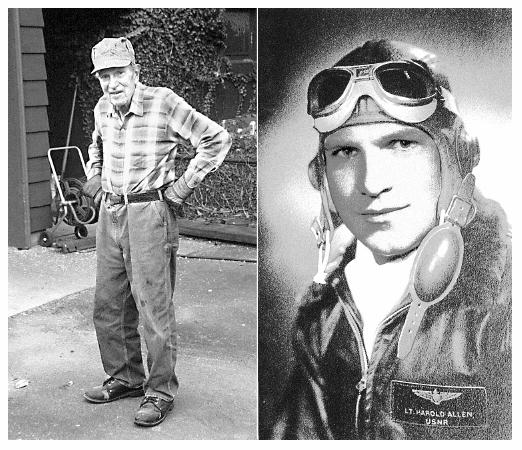The photos show Harold as a W.W. II Naval Aviator, and in later years, as we knew him, ready for a day in the woods with his wonderful miniture steam logging railroad.
Photos provided by: Michael Allen

Dr. Harold F. Allen died Friday, November 16, 2001 at St. Joseph Mercy Hospital of complications following hip replacement surgery. He was 93.
A resident of Ann Arbor since 1946,
Dr. Allen retired in 1972 from the University of Michigan Department of
Aeronautical Engineering, where he was a research engineer. He was born
June 3, 1908 in Ilion, New York, to Charles and Luisa (Haderle) Allen.
He grew up in Parish, New York and received a BS from Syracuse University
in 1929. He worked for General Electric until 1931, leaving to earn an
MS degree in electrical engineering from Syracuse University, where he
taught until 1938.
Always an avid hiker, skier and
camper, Dr. Allen and three friends took a five-week, 10,000-mile tour
of the western United States in 1933. With no paved roads through the Rocky
Mountains, it was sufficiently adventurous that the trip was written up
in the Syracuse paper upon their return. He also climbed and hiked in the
nearby Adirondack Mountains. A panoramic photomural that he made, taken
from the summit of Mt. Marcy, was displayed for many years at the Lake
Placid Club. He was also a licensed bobsled driver on the Olympic
run at Lake Placid. Very interested in aviation since taking his first
airplane flight in 1920, Dr. Allen took his first flying lesson in 1926.
During his years teaching at Syracuse, he would perform aerobatic flight
routines at air shows, using a pontoon- equipped Fleet bi-plane. They called
him The Flying Professor. He spent summers camping in Canada and the northeast,
flying into remote lakes with his seaplane. He also worked flying supplies
into mining camps in the Adirondack Mountains. In 1938 he was asked by
his good friend Merrill Phoenix to serve as co-pilot for a world record
endurance flight in a Piper Cub. Engine failure resulted in a night crash
landing into Onondaga Lake after a record 106 hours aloft!
Dr. Allen was always interested in astronomy, and especially solar eclipses. In 1938 he received a fellowship at the Harvard University Observatory and began working on an additional Master's Degree, but his interest in aviation won out. He took a semester of aeronautical engineering at MIT, then moved to Ann Arbor in 1939, where he taught aerodynamics at the U of M. He earned an MS degree in aeronautical engineering from the U of M in 1941. He married Phyllis Ralph, of Belleville, New York, on April 6,1942, shortly before beginning active duty with the US Navy. Putting his flying experience to good use in World War II, Dr. Allen became a naval aviator. He remained in the Naval Reserve after WWII, retiring from the service in 1968 with the rank of Captain.
Returning to Ann Arbor in 1946, he received his Ph.D. in aeronautical engineering, also at the U of M, where he continued teaching and working as a researcher. In 1952, he met R. Buckminster Fuller, who had conceived the idea of using aircraft aluminum to build a lightweight dome for the Ford Rotunda, and needed to test out his ideas. Dr. Allen supervised the construction and testing of a sample panel for Fuller's first geodesic dome, then monitored the construction of the actual dome, using strain gauges installed throughout the structure. The test panel is now at the Henry Ford Museum. Dr. Allen switched from aircraft to rockets in the mid 1950's, and was active in the first International Geophysical Year of 1957, flying rockets from Wallops Island, Virginia and Fort Churchill, Manitoba. His rocket research later took him to Guam and Point Barrow, Alaska. In 1964 he established the University of Michigan's Keweenaw Rocket Range near Copper Harbor and was the project director through 1971.
In addition to his aviation interest, Dr. Allen's long time hobby was steam locomotives. In 1954, with friends, he planned to establish a museum devoted to logging railways, and acquired several steam locomotives, which were kept near Ann Arbor for many years. They were ultimately transferred to other museums. In 1962, he turned his interest to building a 1/3 scale miniature steam railway, which eventually reached a length of nearly a mile, with four steam locomotives, two of which he constructed himself.
After retiring from the U of M, Dr. Allen became world a traveler. He visited all seven continents, as well as Greenland and New Zealand. He and his wife Phyllis visited Russia and much of Eastern Europe in the '70's, and were early visitors to China. He hiked and climbed mountains in the US and Africa, rode trains throughout the world, searched for covered bridges, followed solar eclipses to Canada, Hawaii and Africa, and even survived a shipwreck in the Antarctic Ocean. When Dr. Allen was 85 years old, he and his son Douglas took a 10-day rafting trip on the Tatshenshini River in Alaska. At age 90, he traveled to Alaska again, to ride a special steam excursion on the White Pass and Yukon Railroad.
He is survived by his wife of 59
years, Phyllis; two sons, Michael (Heather) Allen of Brighton and Douglas
(Maye Thompson) Allen and grandchildren, Pearl and Emmett of Portland,
Oregon. In lieu of flowers, donations may be made to the Nature Conservancy,
Michigan Chapter, 2840 East Grand River Avenue, #5, East Lansing, Michigan
or to the Ecology Center of Ann Arbor, 117 N. Division St, Ann Arbor, 48104.
Return to MMRHS home page